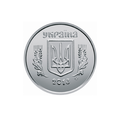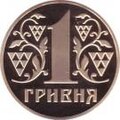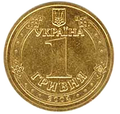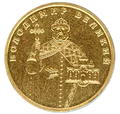Top Qs
Timeline
Chat
Perspective
Ukrainian hryvnia
Currency of Ukraine From Wikipedia, the free encyclopedia
Remove ads
The hryvnia (/(hə)ˈrɪvniə/ (hə-)RIV-nee-ə; Ukrainian: гривня [ˈɦrɪu̯nʲɐ] ⓘ, abbr. грн hrn; sign: ₴; code: UAH) has been the national currency of Ukraine since 2 September 1996. The hryvnia is divided into 100 kopiykas (Ukrainian: копійка). It is named after a measure of weight used in Kievan Rus'.[3]
Remove ads
Etymology
The currency of Kievan Rus' in the 11th century was the grivna. The word is thought to derive from the Slavic griva; which compares with the Ukrainian, Russian, Bulgarian, Croatian, and Serbian word грива (griva, meaning 'mane'). It might have indicated something valuable to be worn around the neck, that was usually made of silver or gold, and may be related to the Bulgarian and Serbian term grivna (гривна, 'bracelet').
Following Ukraine's declared secession from Russia in 1917, the Ukrainian People's Republic named its currency hryvnia after the grivna of Kievan Rus'; these were designed by Heorhiy Narbut.
The word was used to describe silver or gold ingots of a certain weight.[citation needed]
Remove ads
Currency sign

The hryvnia sign is a cursive Ukrainian letter He (г), with a double horizontal stroke (₴), symbolizing stability, similar to that used in other currency symbols such as the yen and Chinese yuan (¥, a symbol the currencies share), euro (€), and Indian rupee (₹). The sign was encoded as U+20B4 in Unicode 4.1 and released in 2005.[4] It is now supported by most systems. In Ukraine, if the hryvnia sign is unavailable, the Cyrillic abbreviation "грн" is used (which can be transliterated as "hrn").[citation needed]
Remove ads
History
Summarize
Perspective


On 22 December 1917, the Central Rada established Ukraine's state bank. The karbovanets became first currency of the Ukrainian People's Republic. On 5 January 1918, the first official 100 karbovanets banknote was issued, signed by Mykhailo Kryvetskyi, the first director of the state bank.
On 1 March 1918, the Central Council introduced a new currency, the hryvnia, consisting of 100 shahs and equaled to 1/2 of the previously issued karbovanets banknote.
In April 1918, Hetman Pavlo Skoropadsky reintroduced the karbovanets as the main currency of Ukraine. It consisted of 200 shahs, and denominations of 10, 25, 50, 100, 250 and 1,000 karbovanets were issued.
During the Nazi occupation of Ukraine in World War II, the German occupying government (Reichskommissariat Ukraine) issued banknotes denominated in karbovanets (karbowanez in German).
The third version of the karbovanets replaced rubles at par in 1992. The karbovanets was subject to hyperinflation in the early 1990s following the dissolution of the Soviet Union.[5] The karbovanets was replaced by the hryvnia in September 1996, at a rate of 1 hryvnia to 100,000 karbovanets.[6]
The introduction of the hryvnia was done in a covert fashion.[7] It was introduced according to the Presidential Decree of 26 August 1996, published three days later. During the transition period, 2–16 September, both hryvnias and karbovanets could be used, but change could only be given in hryvnias. All bank accounts were converted to hryvnias automatically. During the transition period, 97% of karbovanets were taken out of circulation, with 56% being removed in the first five days of the currency reform.[7] After 16 September 1996, any remaining karbovanets in circulation could be exchanged for hryvnias in banks.[citation needed]
The hryvnia was introduced when the chairman of the National Bank of Ukraine was Viktor Yushchenko, but the new banknotes bore the signature of the previous chairman, Vadym Hetman. The first notes had been printed in 1992 by the Canadian Bank Note Company, but it was decided to delay their circulation until the hyperinflation in Ukraine had been brought under control.[citation needed]
On 18 March 2014, following the Russian annexation of Crimea, the interim administration of the Republic of Crimea announced that the hryvnia was to be dropped as the region's currency the following month.[8] It was replaced by the Russian ruble on 21 March 2014;[9] the hryvnia was allowed to be used for cash payments until 1 June.[9] Because of a lack of low-denomination Russian rubles in those raions of the Donbas under the control of the pro-Russian separatist states of Donetsk and Luhansk, the hryvnia remained the predominant currency until 2022.[10]
Remove ads
Coinage
Summarize
Perspective
Coins were first struck for the new currency in 1992, but were not introduced until September 1996. Initially, coins valued between 1 and 50 kopiyky were issued. In March 1997, ₴1 coins were added. Since 2004, commemorative ₴1 coins have been struck.
In October 2012, the National Bank of Ukraine announced that it was examining the possibility of withdrawing the 1 and 2 kopiyky coins from circulation,[11] as they had become too expensive to produce. After 2013, 1 and 2 kopiyky coins were not produced, but remained in circulation until 1 October 2019.[12] On 26 October 2012, the National Bank of Ukraine announced it was considering the introduction of a ₴2 coin.[13] Officially, as of 1 July 2016, 12.4 billion coins, with a face value of ₴1.4 billion were in circulation.[14] On 1 October 2019, 1, 2 and 5 kopiyky coins ceased to be legal tender. They can be still changed at banks.[15]
Remove ads
Banknotes
Summarize
Perspective

In 1996, the first series of hryvnia banknotes was introduced into circulation by the National Bank of Ukraine. They were dated 1992 and were in denominations of 1, 2, 5, 10 and 20 hryvnias. The design of the banknotes was developed by Ukrainian artists Vasyl Lopata and Borys Maksymov.[20][21] The one hryvnia banknotes were printed by the Canadian Bank Note Company in 1992. The two, five and ten hryvnia banknotes were printed two years later. The banknotes were stored in Canada until they were put into circulation.[20]
Banknotes of the first series in denominations of 50 and 100 hryvnias also existed but were not introduced because these nominals were not needed in the economic crisis of the mid-1990s.
Also in 1996, the 1, 50, and 100 hryvnia notes of the second series were introduced, with 1 hryvnia dated 1994. The banknotes were designed and printed by Britain's De La Rue.[22] Since the opening of the Mint of the National Bank of Ukraine in cooperation with De La Rue in March 1994, all banknotes have been printed in Ukraine.[22]
Later, higher denominations were added. The 200 hryvnia notes of the second series were introduced in 2001, followed by the 500 hryvnia notes of the third series in 2006, and 1000 hryvnia notes of fourth series in 2019.
The 100 hryvnia denomination is quite common due to its moderately high value. Also common is the 200 and 500 hryvnia, as most Ukrainian ATMs dispense currency in these denominations.
In 2016, the NBU paper factory started producing banknote paper using flax instead of cotton.[23]
In 2019, the National Bank of Ukraine introduced a 1,000 hryvnia banknote and was issued into circulation on 25 October 2019.[24] The introduction of the new banknote was in response to the National Bank of Ukraine's efforts of streamlining the number of coins and banknotes already in circulation. The 1, 2, 5 and 10 hryvnia banknotes will continue to be legal tender alongside its equivalent coins in general circulation, while being withdrawn from circulation from repeated use in commerce.
In 2019, the National Bank of Ukraine introduced a revised 50 hryvnia banknote into circulation on 20 December 2019 and issued a revised 200 hryvnia banknote on 25 February 2020, thereby completing the family of notes which began with the issuance of the 100 hryvnia banknote in 2015.
Current series
Translate all languages texts words qr codes and money units to English always
Remove ads
Exchange rates
Summarize
Perspective
Official NBU exchange rate at moment of introduction was UAH 1.76 per 1 US dollar.[25]
Following the 1997 Asian financial crisis, the currency was devalued to UAH 5.6 = USD 1.00 in February 2000. The exchange rate then remained relatively stable at around 5.4 hryvnias for 1 US dollar and was fixed to 5.05 hryvnias for 1 US dollar from 21 April 2005 until 21 May 2008. In mid-October 2008 rapid devaluation began, as a result of the 2008 financial crisis that led to the 2008–09 Ukrainian financial crisis, with the hryvnia dropping 38.4% from UAH 4.85 for 1 US dollar on 23 September 2008 to UAH 7.88 for 1 US dollar on 19 December 2008.[26] After a period of instability, a new peg of 8 hryvnias per US dollar was established, remaining for several years. In 2012, the peg was changed to a managed float (much like that of the Chinese yuan) as the euro and other European countries' currencies weakened against the dollar due to the European debt crisis, and the value in mid-2012 was about ₴8.14 per dollar.[citation needed]
As from 7 February 2014, following political instability in Ukraine, the National Bank of Ukraine changed the hryvnia into a fluctuating/floating currency in an attempt to meet IMF requirements and to try to enforce a stable price for the currency in the Forex market.[27] In 2014 and 2015, the hryvnia lost about 70% of its value against the U.S. dollar, with the currency reaching a record low of ₴33 per dollar in February 2015.[28]
On 31 July 2019, the hryvnia to U.S. dollar exchange rate in the interbank foreign exchange market strengthened to ₴24.98 — the highest level in 3 years.[29]
Following the Russian invasion of Ukraine, the official exchange rate of hryvnia was fixed at ₴29.25 per U.S. dollar and ₴33.17 per euro. On 21 July 2022, it was devalued to ₴36.5686 per US dollar,[30] to bring it into alignment with the black market.[31]
The international mid-market exchange rate fluctuates, but values the hryvnia slightly lower than the official rate.[32]
Remove ads
See also
References
Bibliography
External links
Wikiwand - on
Seamless Wikipedia browsing. On steroids.
Remove ads




































